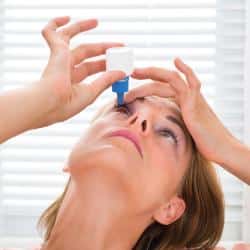
These are just the most noticeable symptoms of dry eyes — one of the most common vision problems in the country, estimated to be most prevalent in middle-aged and older women.
Dry Eye Syndrome symptoms range from mild to severe. Treatments also vary depending on the symptoms and specific cause. While most people with dry eye may not realize that they have dry eye symptoms and consider it a nuisance at first, severe cases may require surgery to prevent dry eye vision loss.
It’s important to learn about possible causes of dry eyes, treatment options, and what can be done to prevent mild symptoms from turning into severe cases.
It may not be that obvious, but consistent and adequate production of tears keep your eyes comfortable and functioning. By keeping your eyes consistently moist, your tears wash away dust, debris, and microorganisms.
Normally, tears are made up of three crucial components: oil, water, and mucus. The oily component (produced by the meibomian glands) is the outermost layer and slows down the evaporation of tears from the eye’s surface.
On the other hand, the watery component (produced by the lacrimal glands) makes sure that your eyes are sufficiently moistened. The mucus layer (produced by the cells lining the cornea and conjunctiva) helps anchor tears to the surface of the eye for it to spread evenly.
By and large, dry eye symptoms result from the following:
- Inadequate production of tears by the tear ducts
- Poor quality of tears (lacking one or two components)
These issues may be a result of one or a combination of the following factors:
Dry Eye and Aging
Dry eye symptoms become more prevalent with age. It’s estimated that 3.2 million women and 1.6 million men aged 50 years and above suffer from moderate to severe cases of dry eye (PDF) in the United States.
Dye eye syndrome as a result of aging can be further attributed to the following:
- Decreased tear production – Aging brings on natural changes that can slow down tear production.
- Menopause – Dry eyes is common amongst menopausal women due to hormonal imbalances.
- Medications – Certain medications can create dry eyes, including but not limited to antidepressants, antihistamines, muscle relaxants, birth-control pills, diuretics, and sleeping pills.
Dry Eye Contributing Factors – Medical Conditions
Some people are born with eye structure problems. The eyelids may not close properly or tear ducts may be blocked resulting in inadequate tear production.
There’s also Sjogren’s Syndrome. This autoimmune condition is common in women and is often misdiagnosed as menopause. Apart from dry eyes, Sjogren’s Syndrome can also lead to excessive dryness in other parts of the body.
Other medical conditions that can result to dry eyes include:
- Rheumatoid Arthritis
- Collagen Vascular Disease
- Acne and Rosacea
- Blepharitis (inflammation of the eyelids)
- Meibomitis (inflammation of the meibomian glands that line the eyelids)
- Allergies
Other Risk Factors of Dry Eye Syndrome
Everything from cancer treatments to pregnancy to too much screen time increase the possibility of dry eye. Other risk factors include, smoking, contact lens use, dry and windy climates, hormone replacement therapy and other eye surgeries.
Some of these things are unavoidable but being aware of them can remind you that dry eye is a treatable condition.
Dry Eye Symptoms
The following symptoms can appear abruptly or gradually, lasting from hours to days to all the time.
- Redness
- Eye pain
- Feeling of “something foreign” in the eyes
- Episodes of excessive tearing (sounds counterintuitive but this is often a result of the eyes’ attempts to lubricate the eyes)
- Gritty or sandy feeling in the eyes
- Eyelids that tend to stick together when you wake up
Dry Eye Syndrome
If left unchecked, severe Dry Eye Syndrome can be excruciatingly painful. Thinning, scarring, or perforation of the cornea may result from prolonged dryness of the eye’s surface. This could potentially lead to permanent vision loss from dry eyes.
Is Dry Eye Treatable?
While Dry Eye Syndrome can be a chronic condition, it is usually more easily managed the earlier you address the problem. Waiting until it is a more significant concern makes it more difficult to treat. When surgery is the option, it’s usually because it has to do with structural problems, like congenital issues.
Treatment for dry eyes can range from providing relief to reducing inflammation to surgery. These include the following:
- Artificial tears
- Homemade warm compresses (Warm not hot heating pads or hot water skins/bottles with fabric wrapped around them) applied to the eyes help increase circulation and make tears more fluid.
- Prescription eye drops for dry eyes
- Slow-release lubricants
- Punctal plugs (a procedure where collagen or silicone plugs are inserted painlessly into the lacrimal ducts)
- Punctal cautery (simple surgery that permanently closes the drainage holes to keep tears on the eye’s surface for a longer period of time)
Download our Complete Guide to Dry Eyes.

